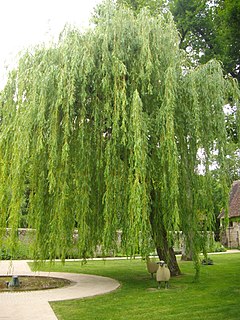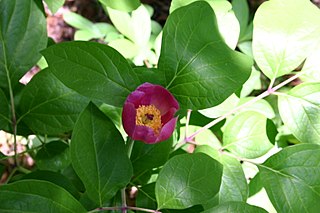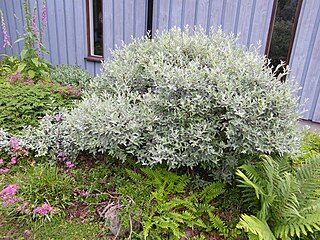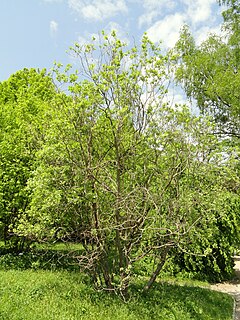
Salix babylonica is a species of willow native to dry areas of northern China, but cultivated for millennia elsewhere in Asia, being traded along the Silk Road to southwest Asia and Europe.

Leitneria floridana (corkwood), the sole species in the genus Leitneria, is a deciduous dioecious shrub or small tree, found only in the southern United States states of Arkansas, Florida, Georgia, Missouri and Texas.

Baldellia is a genus of aquatic plants commonly known as lesser water-plantains. It includes three species found across much of Europe and the Mediterranean from Ireland and the Canary Islands to Turkey and Estonia. The genus is named in honor of the Italian nobleman Bartolomea Bartoloni-Baldelli. Baldellia is very closely related to Echinodorus.

Scheuchzeria palustris, is a flowering plant in the family Scheuchzeriaceae, in which there is only one species and Scheuchzeria is the only genus. In the APG II system it is placed in the order Alismatales of the monocots.

Baeckea is a genus of flowering plants in the myrtle family, Myrtaceae. There are about 75 species, of which 70 are endemic to Australia; the others are distributed in New Caledonia and Southeast Asia.

Heinrich Wawra Ritter von Fernsee, born Jindřich Blažej Vávra, was a Czech-Austrian ship surgeon, botanist and explorer.

Bougainvillea glabra, the lesser bougainvillea or paperflower, is the most common species of bougainvillea used for bonsai. The epithet 'glabra' comes from Latin and means "bald".

Koeleria is a common and widespread genus of plants in the grass family, found on all continents except Antarctica and on various oceanic islands. It includes species known generally as Junegrasses.

Salix triandra, with the common names almond willow or almond-leaved willow, is a species of willow native to Europe and Western and Central Asia. It is found from south-eastern England east to Lake Baikal, and south to Spain and the Mediterranean east to the Caucasus, and the Alborz Mountains. It usually grows in riparian habitats, on river and stream banks, and in wetlands.

Paeonia obovata is a perennial herbaceous species of peony of 30–70 cm high. It has white to purple-red flowers and its lower leaves consist of no more than nine leaflets or segments. In China the vernacular name of the typical subspecies is 草芍药, meaning "grass peony", while ssp. willmottiae is known as 拟草芍药, "false grass peony". In Russia this species is called Пион обратно-овальный, or "inverted egg-shaped peony". In Japanese, it is known as ヤマシャクヤク (yamashakuyaku), meaning "mountain peony". In English it is sometimes called woodland peony. It grows naturally in warm-temperate to cold China, including Manchuria, and in Korea, Japan, Far Eastern Russia and on Sakhalin.

Trachycarpus martianus is a species in the genus Trachycarpus from two distinct populations, one at 1,500 m (4,900 ft) in the Khasia Hills, Meghalaya Province, in northeast India, the other at 2,400 m (7,900 ft) in central northern Nepal. Other populations have been reported in Assam, Sikkim, Burma and southern China. The main identifying characteristics are the regular leaf splits, the coffee bean shaped seeds and the bare, as opposed to fibrous trunk. The new leaf spear and edges of the petioles are covered with a white tomentum.

Helminthotheca echioides, known as bristly oxtongue, is a stiff annual or biennial herb native to Europe and North Africa. It was traditionally used as an antihelminthic treatment.

Panicum sumatrense, known as little millet, is a species of millet in the family Poaceae.

Ajania is a genus of flowering plants in the daisy family, described as a genus in 1955. The genus is native to temperate Asia, primarily Russia and China. It is named after the Russian port city Ayan in the Khabarovsk Krai region of the Russian Far East, on the coast of the Sea of Okhotsk.

Puya mirabilis is a species of Bromeliad in the genus Puya. This species is native to Bolivia.

Salix lapponum, the downy willow, is a low, much branched shrub having a wide distribution in Northern Europe, eastwards to the Altai and western Siberia, and is found as far south as the Pyrenees and Bulgaria. In Scotland it can be found on rocky mountain slopes and cliffs, generally at altitudes between 200 and 900 metres.

Salix aegyptiaca, known as the Persian willow, is a large shrub or small tree from the genus of willow (Salix) with red branches that are tomentose in the first two years and leaves up to 15 centimeters long. The natural range of the species is in the Caucasus and in western Asia. It is cultivated in many countries.

Salix argyracea is a large shrub from the genus of willow (Salix) with up to 10 centimeters long leaf blades with a felty hairy and shiny underside. The natural range of the species is in Kazakhstan, Kyrgyzstan, and China.

Salix argyracea, the smooth willow, is a small shrub from the genus of willow (Salix). It is found in the mountainous areas of several European countries.
Salix cathayana is a strongly branched shrub from the genus of the willow (Salix) with brown or gray-brown, young tomentose hairy branches. The leaf blades have lengths of 1.5 to 5.2 centimeters. The natural range of the species is in the north of China.


















